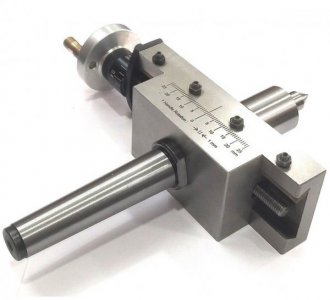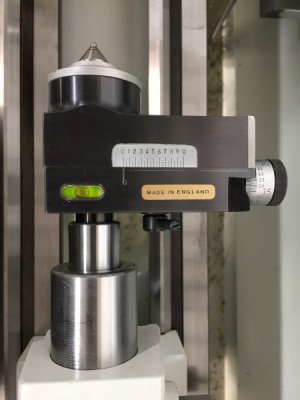Let me offer some food for thought, although the choice of boring bar is up to you. You have an Excel Mill Drill, which is a benchtop mill similar to an RF-30, correct? I would consider the forces the head generates as part of your decision tree.
The boring bars in a boring head encounter the same three forces they do on the lathe - axial, tangential and radial forces. However, the MILL experiences an additional force - Centripetal Force. This is a real force that is sustained by the mill, which is why a bigger mill with bigger mass that can go slow enough can bore bigger holes. Not to get too technical here but it will help you think this through. The formula for Centripetal Force is:
Centripetal force = mv2/r, where
m = the offset center of mass from the spin axis,
v = rotational speed and
r = radius of the tool holder/tool assembly. The forum software won't allow exponents so note that this is MV(squared) / R. Things to note:
- M is your boring bar. The bigger and/or heavier the bar is, the bigger the CF becomes.
- V is your rotational speed. The faster you go, the greater the CF becomes ... very quickly.
- R is the extension of the bar out from the spindle centerline. Note that as R increases, CF actually decreases. What this means is that as your required hole gets bigger, CF gets smaller IF you can go slow enough.
- When CF reaches a certain point it will begin to cause the mill to move or vibrate. This varies with the mill, speed, size of the boring bars, how much extension you have on the boring head, type of boring bar you're using (HSS, cobalt, brazed carbide or inserted carbide). If you use a big enough bar and go fast enough, the CF can get big enough to make the mill literally walk across the shop and down your driveway. This is also why a bigger, heavy mill can bore bigger holes - it has the mass to resist the CF the head generates. Got it?
With the above in mind, and remembering we are speaking of a benchtop mill, smaller bars are probably a good idea. You might think that there is little difference between the weight of 3/8" and 1/2" bars but there is where CF is concerned. Using sleeves with smaller bars also adds to the mass. I suspect your mill can handle 1/2" bars if you bore out to maybe a max of 3" or so. Beyond that and the mill may start to vibrate if you cannot go slow enough.
I have multiple boring heads that take either 3/8" or 1/2" bars and whenever I can, I use the head with the smaller bars and this is especially true when the bore diameter goes up. This allows me to go faster for a better finish without the mill moving much at all. On smaller bores, the size of the bar becomes less important.
As for the side hole, I suggest you incorporate it if you can, not just because it allows you to put a boring bar there to bore bigger holes but also because you can put a shaft in there that holds adjustable weights to counter CF. We'll talk more about this after I build one.
In any case, think about it before you drill holes.




